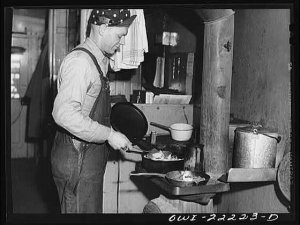CABOOSE CUSINE From “CABOOSE” written by Mike Schafer

"Cooking aboard a caboose was almost an art unto itself – and unfortunately it has become a lost art. The need for cooking abilities was high during the era when crews literally lived aboard cabooses for two or three days at a time during a round trip over the division. The need for culinary skills lessened as travel times were shortened and the number of eating establishments – “fast food” or otherwise – that were within a reasonable proximity of the railroad crew."
"Some restaurants are good some are not so good, and such was the case with caboose cooking. As low man on the totem pole, the brakeman or flagman often was designated as chief cook and bottle washer unless the conductor had a penchant for cooking – and a few did. Otherwise, for the flagman it was a baptism by fire: learn to cook or you and your fellow crew members would starve. In an earlier era, mainline cabooses usually had ample refrigerator and storage space for foodstuffs. It took a lot of food to keep a crew of two or three well fed during the course of a two or three day round trip out of a home terminal. Crews were responsible for providing their own food, and they often did so with a respectable degree of creativity. "
"Undoubtedly, a lot of produce was acquired surreptitiously, such as when a train had to make an “inspection stop” that coincidentally was adjacent to a farmer’s cornfield – or even a chicken house. Fresh eggs for breakfast; fresh chicken for dinner. Some crews even came equipped with a shotgun or fishing tackle in hopes of tagging trackside delicacies like quail or snagging some bass or catfish from any creek bridges the train might happen to be stopped upon."
"Chester “Chet” French, a longtime conductor on the Illinois Central Railroad, recalls his days living and working in cabooses: “The cooking came in various degrees of quality” he snickered, the crew usually would buy groceries en route, and the flagman was usually chosen to prepare the food. We had one conductor, Fred Carrithers, I worked with in the late 1970’s and early 1980,s who had found an old Dutch oven at an antique shop. He put the contraption on top of the oil stove in the caboose and went to work. Of course to make it work properly. We had to turn the oil stove up full bore; in the summertime this made the inside of the caboose unbearable. But it made for some great food – baked pork chops, potatoes, corn and such. He could actually bake rolls – you know the ones in the cardboard tube.
“On our run south (between Freeport and Clinton Illinois), we’d eat dinner somewhere between Minonk and Bloomington before tying up for the night at Clinton. On our return trip the next morning, with a pot full of coffee, we’d always have more of the rolls he’d made the night before. Before we turned the stove down, we’d boil water and then do the dishes.” Chet went on to recall, “One Friday morning, Carrithers prepared an excellent breakfast of eggs, bacon and bread. Then he discovered his entire crew - who was staring lustfully at the big mound of bacon –was Catholic. He dipped his hand in some water and sprinkled it on the bacon. “Swim, dangit, swim!” he said, blessing it into ‘fish’ so the guys could eat without guilt.”
 WELCOME
WELCOME  HOBOS!
HOBOS! 






























